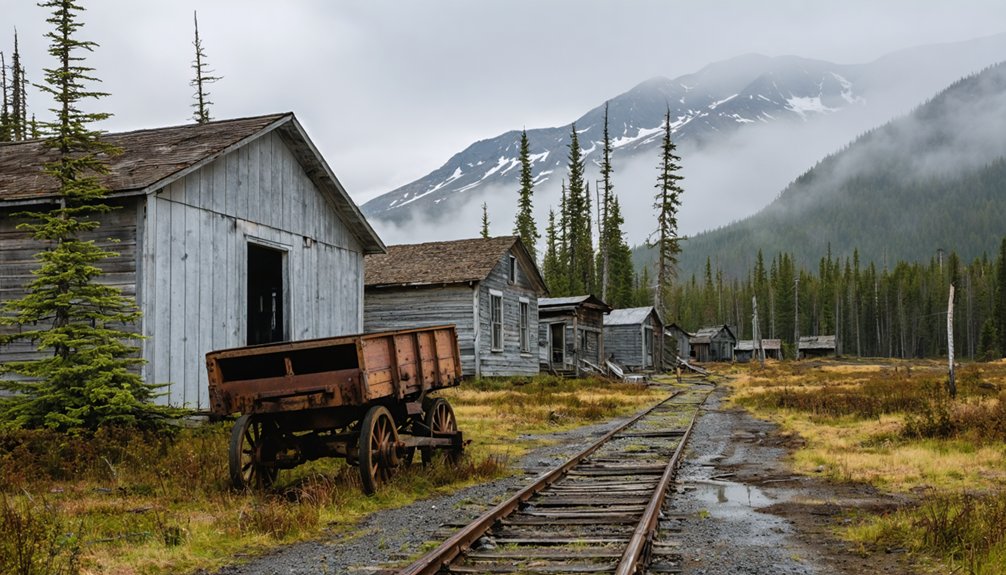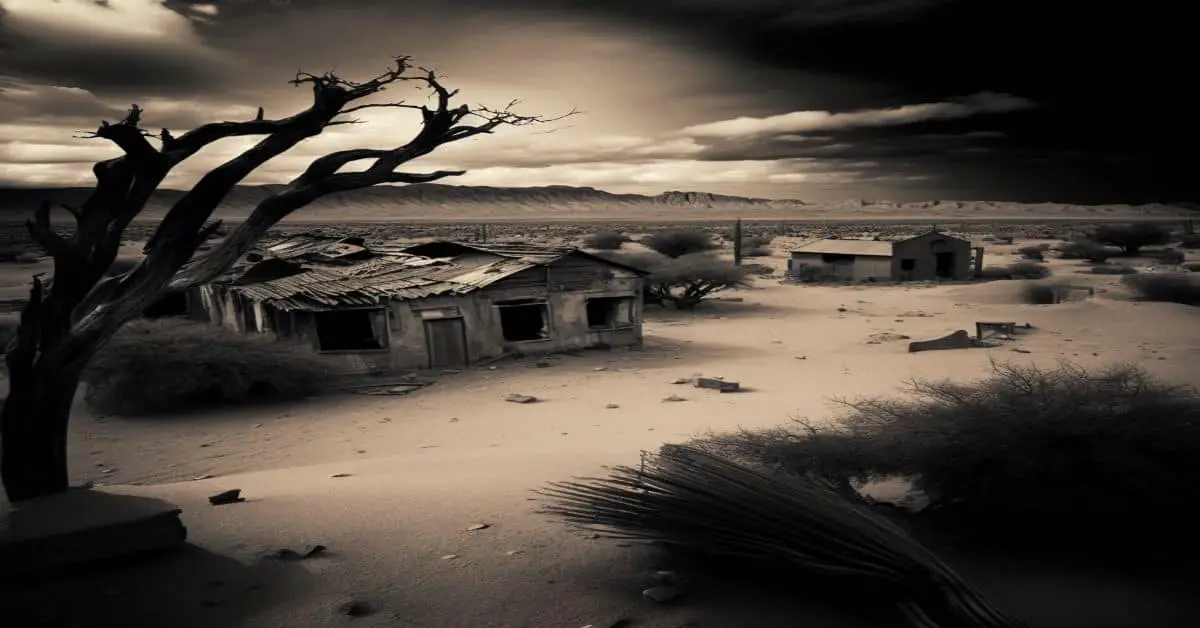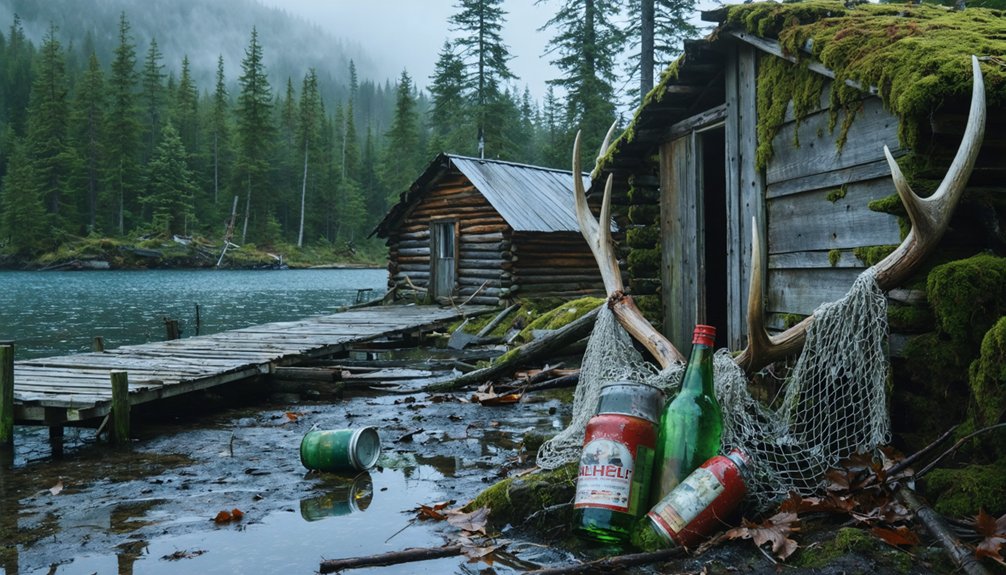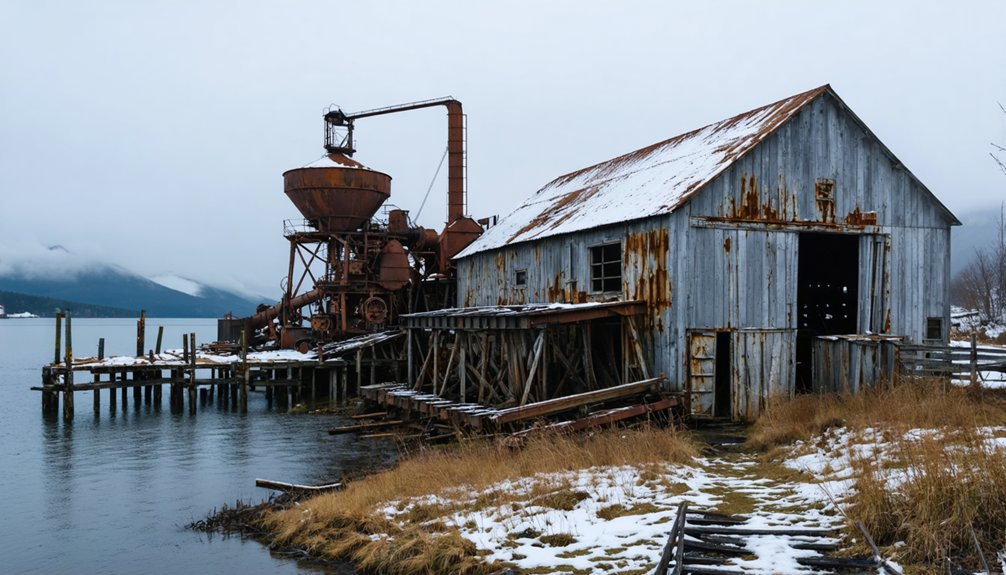York, Alaska emerged as a tin mining settlement in 1900 when the U.S. Geological Survey discovered stream tin in the region. You’ll find its story began with W.C.J. Bartels’ establishment of the first mining company in 1903, leading to significant investments after uranium and tungsten discoveries. The harsh frontier town operated seasonally due to permafrost, relying on dog teams for transportation. While the 1918 influenza epidemic led to York’s abandonment, its brief but dramatic history holds countless untold tales.
Key Takeaways
- York began as a tin mining settlement in 1900 following discoveries by the U.S. Geological Survey in Alaska’s York district.
- The town experienced a brief boom after W.C.J. Bartels claimed finding $100 million worth of tin ore in 1902.
- Mining operations were seasonal due to permafrost, with workers enduring harsh conditions during 10-12 hour shifts.
- The settlement consisted of temporary structures and log cabins, with population dropping to 20-30 people after initial excitement.
- York became a ghost town after the 1918 influenza epidemic killed its remaining residents, leaving minimal archaeological evidence behind.
The Rise of York’s Tin Mining Community
The discovery of stream tin in Alaska’s York district marked a pivotal moment in the region’s mining history. When U.S. Geological Survey first identified tin deposits on Buhner Creek in 1900, you’d have witnessed the beginnings of a promising mining frontier.
The real catalyst came in 1902 when W.C.J. Bartels discovered the first tin lode, establishing his mining company a year later. Initial excitement peaked when Bartels announced finding $100 million worth of tin ore.
Bartels’ groundbreaking tin lode discovery in 1902 sparked a mining revolution, leading to his company’s founding the following year.
As news spread of ore samples containing uranium and tungsten, you’d have seen rapid community growth driven by substantial investments. During the Great Depression era, metal prices declined sharply for tin and other minerals, severely impacting York’s mining operations.
The American Tin Company and York Dredging Company emerged as major players, bringing sophisticated equipment like the 800-cubic-yard capacity dredge to Buck Creek.
Their ambitious plans included smelters, stamp mills, and windmill-powered operations, transforming York from a remote outpost into a bustling tin mining community.
Life in Early 1900s York
You’d find York’s daily mining operations centered around the extraction of tin, with miners trudging through harsh conditions using basic tools and primitive equipment to work their claims.
Transportation relied heavily on dog teams, which proved essential for hauling supplies and ore across the challenging Alaskan terrain in both summer and winter conditions. Like many other settlements that emerged during the gold rushes of the 1890s, York attracted prospectors seeking their fortune in Alaska’s resource-rich territory.
The community’s living structures consisted primarily of hastily built cabins and tents, clustered together to create a makeshift town that served the mining population’s basic needs. Despite early promise, the settlement’s population quickly declined to just 20 to 30 people by the autumn of 1900.
Daily Mining Operations
During the early 1900s in York, Alaska, mining operations functioned on a strictly seasonal basis, with activity confined to summer months due to the region’s harsh permafrost conditions and freezing winters.
You’d find dredge operations working the creek beds, with massive floating machines scooping up gravel and processing minerals through sluices and screens. These mechanical giants vastly improved efficiency over earlier hand methods.
The daily grind involved intense manual labor, with miners working 10-12 hour shifts. You’d spend your time maintaining dredges, clearing overburden, and making constant equipment repairs. Similar to operations at the Apollo Mine, miners processed ore through free milling techniques. Like the Fort Knox Mine today, these operations required hundreds of workers to keep running smoothly.
When not working the mines, you’d live in basic tents or wooden structures, supplementing shipped supplies with local hunting and fishing.
Despite the challenging conditions, the freedom of the frontier drew prospectors seeking their fortune in this remote Alaskan outpost.
Transportation and Dog Teams
While railroads gradually expanded across Alaska in the early 1900s, York’s remote location made dog teams the most reliable form of transportation for miners and supplies. The Alaska Railroad construction that began in 1903 would eventually transform transportation across much of the territory.
You’d find these hardy dog sledding teams maneuvering treacherous winter conditions, hauling mail and vital goods between mining camps, railheads, and coastal ports. Without developed roads, mushers would lead teams of up to a dozen dogs across snow-covered terrain, muskeg, and frozen waterways.
Before the first bus in 1925, Fairbanks residents relied heavily on dog teams for their transportation needs.
During ice-free months, you could travel by boat along the region’s waterways, but winter transportation demanded the unique capabilities of dog teams.
They’d power through deep snow and brutal cold, connecting York to important supply routes until the 1920s when motorized vehicles began appearing.
Even then, the challenging landscape meant dog teams remained essential for accessing the most remote areas around York.
Community Living Structures
Life in early 1900s York centered around a collection of log cabins and frame buildings that formed the heart of this mining settlement. The rugged log cabin architecture reflected the practical needs of frontier living, while the more substantial frame building features demonstrated the town’s role as a regional distribution hub. Census data collection was exceptionally challenging as bidarkies and sleds were needed to reach this remote location.
You’d find these structures serving multiple purposes in the community:
- Log cabins utilized local timber, providing quick, sturdy shelter against harsh Alaskan elements.
- The half-dozen frame buildings housed essential services and trading activities.
- Temporary structures accommodated the fluctuating population of miners and traders.
- Communal spaces within these buildings offered shelter for social gatherings and resource sharing.
These structures, though modest, created a functioning community where residents could weather isolation and extreme conditions while pursuing their mining ambitions. Similar to other settlements that emerged during the gold rush of 1896, York’s development was driven by prospectors seeking fortune in Alaska’s mineral-rich territories.
The Purple Death Arrives
As the deadly Spanish flu swept into Alaska’s remote regions in 1918, York and nearby settlements faced devastation unlike anything they’d experienced before. The virus moved swiftly along trade routes, overwhelming Indigenous communities that had limited exposure to Western diseases.
You’ll find the pandemic’s impact was catastrophic – nearby Wales lost 200 people, while settlements along the American and Agiapuk Rivers lost 98 residents.
Medical care was virtually nonexistent, with the nearest facility in distant Seward. Communities struggled as caregivers and gravediggers fell ill themselves.
The Spanish flu’s cultural impact was particularly severe, as it claimed the lives of many elders who held traditional knowledge. In some villages, you’d have witnessed entire adult populations vanish, leaving only children and elderly survivors to maintain their way of life.
A Settlement Lost to History
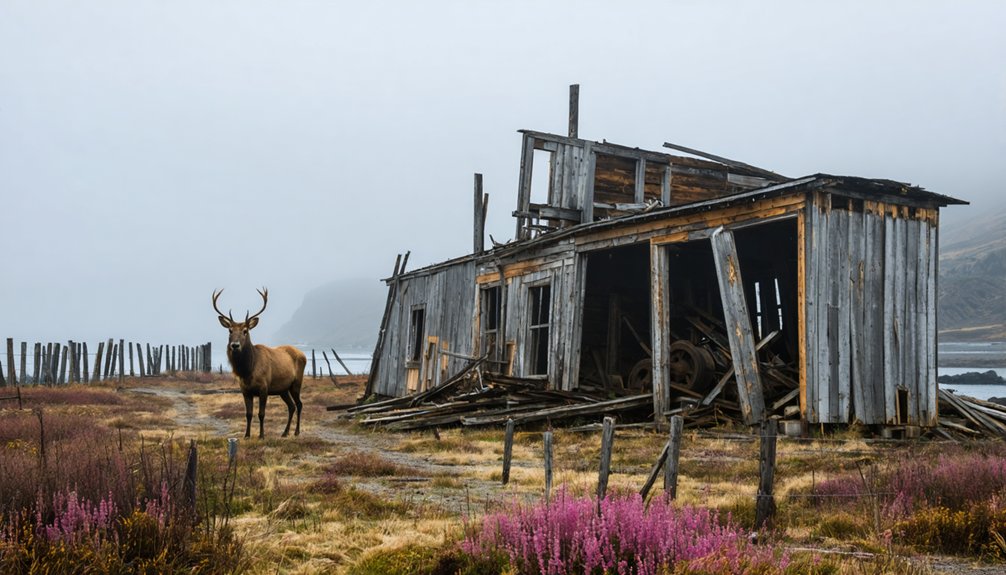
While archaeological evidence of York remains scarce today, you’ll find only scattered traces of the mining settlement‘s brief existence through rare photographs and fragmentary reports from the early 1900s.
The town’s mysterious absence from the 1910 Census compounds the difficulty in piecing together detailed information about its population and daily life.
What’s known about York comes primarily from documentation of its tragic end during the 1918 influenza epidemic, leaving much of its short history shrouded in uncertainty.
Archaeological Evidence Remains Limited
Despite extensive interest in Alaskan ghost towns, archaeological evidence about York remains frustratingly limited. The town’s remote location on the Seward Peninsula, coupled with harsh climatic conditions, has created significant archaeological limitations.
You’ll find that historical documentation is particularly sparse, with even the 1910 census data missing from the records.
Key challenges in uncovering York’s past include:
- No reported use of ground-penetrating radar or geophysical imaging techniques
- Absence of significant archaeological excavation projects
- Limited preservation of artifacts despite permafrost conditions
- Lack of thorough historical records about the settlement’s inhabitants
The Spanish flu pandemic‘s impact on York’s population, combined with its isolated location, has left researchers with more questions than answers about this mining settlement’s brief existence.
Mining Town’s Brief Existence
Located along York Creek in Alaska’s Seward Peninsula, the mining settlement of York emerged as a modest operation focused primarily on tungsten and tin extraction from alluvial placer deposits.
Unlike more prominent Alaskan mining towns, you won’t find evidence of extensive infrastructure or long-term settlement here. The site’s mining techniques included churn-drilling and basic placer mining, reflecting the economic challenges of working in such remote terrain.
York’s brief existence followed the typical boom-and-bust pattern of small Alaskan mining camps. Without major corporate backing or rail connections, the settlement remained small, hosting primarily short-term workers who battled harsh environmental conditions.
The town’s population dwindled quickly once mineral yields proved modest, with only trace amounts of tin found in the gravel deposits over shale bedrock.
Missing Census Records Mystery
After York vanished from federal census records in the early 1900s, the town’s demographic history became shrouded in mystery. The census discrepancies stem from Alaska’s unique territorial challenges and the devastating impact of the 1918 flu pandemic.
Key factors that complicated population tracking in York:
- Absence from the 1910 federal Alaska census, despite enumeration of nearby villages
- Lack of county governance, forcing reliance on judicial divisions for record-keeping
- Limited coverage of early Alaska censuses between 1870-1907, leaving significant gaps
- Complete loss of residents to the 1918 pandemic, halting all future census appearances
With no surviving birth, death, or marriage records, and the total extinction of York’s population, you’ll find reconstructing the town’s demographic history remains virtually impossible.
Geographic Isolation and Survival
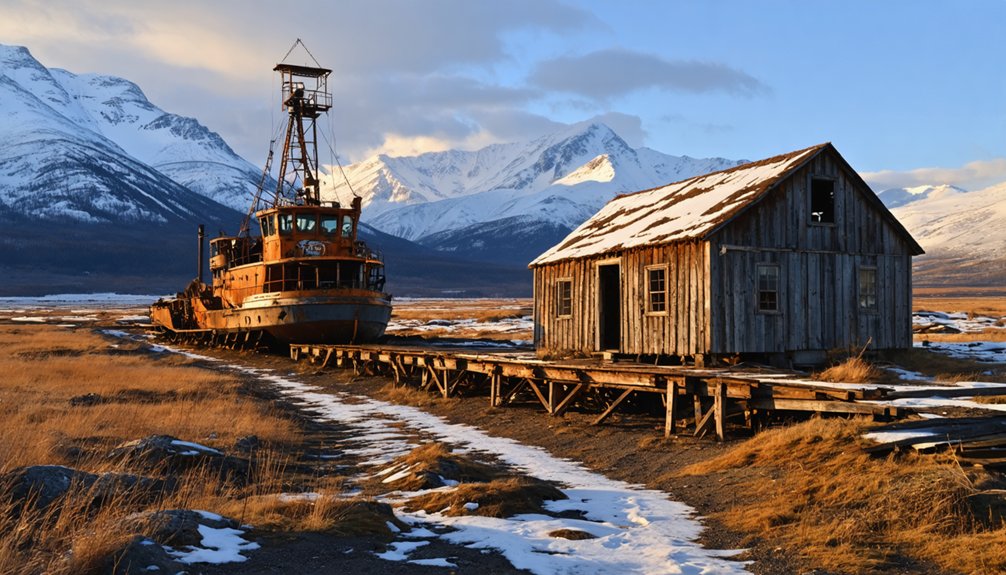
While many Alaskan settlements faced isolation, York’s geographic barriers created exceptional survival challenges for its inhabitants. You’d find yourself cut off by mountains, rivers, and dense forests, with no direct access to highways or railways.
These geographic barriers meant you couldn’t simply drive to the nearest town for supplies – everything had to be meticulously planned and stockpiled before winter’s arrival.
Your survival strategies would’ve centered on self-reliance and community cooperation. You’d need to master hunting, fishing, and basic repair skills while maintaining strong connections with your neighbors.
Without reliable cellular service or internet, you’d depend on satellite phones and radio communications. The harsh climate, with its subzero temperatures and seasonal darkness, would demand constant vigilance and adaptation to maintain your independence in this unforgiving landscape.
The Legacy of York’s Last Residents
The devastating 1918 influenza epidemic marked the final chapter of York’s existence, claiming the lives of every resident in this remote Alaskan settlement. Today, the resident memories and community legacy of York’s last inhabitants serve as a powerful reminder of the vulnerability of isolated frontier communities.
- York’s fate highlights the critical challenges faced by remote settlements, where the post office’s closure in 1902 had already signaled economic decline.
- The community’s complete loss during the epidemic left an indelible mark on neighboring settlements like Wales.
- Historical records and census documents preserve the memory of York’s final residents.
- The settlement’s tragic end demonstrates how isolation and limited healthcare access can impact survival during health crises.
The story of York’s last residents continues to influence our understanding of pandemic responses in remote locations.
Preserving York’s Story Today
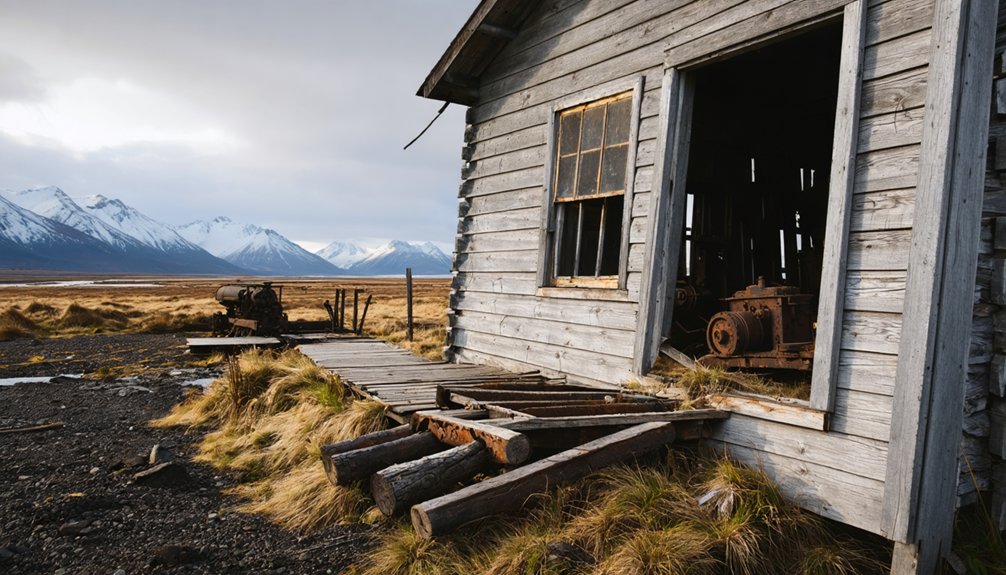
Modern preservation efforts at York blend traditional conservation with cutting-edge technology to safeguard this historic Alaskan ghost town.
You’ll find the National Park Service leading initiatives to stabilize the iconic 14-story mill and other vulnerable structures, while digital preservation techniques like 3D scanning create virtual records of these fragile buildings.
Through community stewardship, you’re able to explore York’s story in innovative ways.
Virtual reality tours let you experience the site remotely, while augmented reality overlays bring historical industrial processes to life.
Local partnerships between the NPS, private cabin owners, and tour operators guarantee responsible access to the site.
The revenue from guided tours and nearby lodging helps fund ongoing preservation work, creating a sustainable model that protects York’s heritage for future generations.
Frequently Asked Questions
Are There Any Surviving Photographs of York’s Tin Mining Operations?
While you won’t find tons of specific York photos, you can discover scattered images in photo archives showing the region’s mining history, especially through Frank Nowell’s 1906 collection of nearby Tin City operations.
What Happened to the Mining Equipment and Structures After York’s Abandonment?
You’ll find most mining equipment and abandoned structures were left behind due to high transportation costs, with materials gradually deteriorating from Alaska’s harsh weather or being salvaged by scavengers over time.
Did Any Former York Residents Leave Written Accounts or Diaries?
You won’t find any written accounts or diaries from former residents of this settlement. The historical record shows no personal documents survived, with the story told only through external newspaper reports.
Were There Attempts to Resettle York After the 1918 Pandemic?
Like a winter-frozen shore, York remained untouched. You won’t find evidence of any resettlement efforts after the 1918 pandemic’s devastating impact – harsh conditions and isolation kept potential settlers away.
How Did Mail and Supplies Reach York During Its Active Years?
You’d find mail routes combined steamships in summer with dog sleds in winter, while the supply chain relied on waterways during warm months and animal-powered transport through frozen terrain.
References
- https://live.laborstats.alaska.gov/sites/default/files/trends/may24art2_0.pdf
- https://www.youtube.com/watch?v=Cz0IGc2Uy0E
- https://www.thealaskalife.com/blogs/news/alaska-ghost-towns-youve-probably-never-heard-of
- https://www.geotab.com/ghost-towns/
- http://freepages.rootsweb.com/~gtusa/history/usa/ak.htm
- https://en.wikipedia.org/wiki/List_of_ghost_towns_in_Alaska
- https://www.youtube.com/watch?v=xaNERTG53Oo
- https://pubs.usgs.gov/bul/0622b/report.pdf
- https://www.miningnewsnorth.com/story/2019/08/01/northern-mining-history/the-hope-of-a-nation-within-tin-city/5847.html
- https://www.alaskaminers.org/mining-history-in-ak
